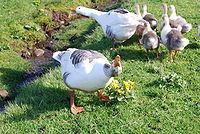 | ||
Mass Male: 5 – 5.5 kg (Adult), Female: 4 – 4.5 kg (Adult) Similar Suchovy goose, Scania goose, Shetland goose, West of England Goose, Twente goose | ||
The Faroese goose (Føroyska Gásin in Faroese) is probably the oldest form of tame goose in Europe and possibly the direct descendants of the tame geese that the Landnám folk brought from Scandinavia and the British Isles.
Since the Faroe Islands have no predator that can kill the geese, there has developed a special "goose culture" in the Faroe Islands, which has no equivalent in neighboring countries. From May to October there can be seen flocks of geese walking freely in the outfields, where they feed on the short summer grass, without any supplementary feeding.
In winter the geese move freely in the cultivated infields of the villages. In some villages the infield is of such good quality that earlier the geese did not even need complementary feed in the winter. However, in most places there is given complementary food when there is snow, and just before and during egg laying. The properties that the Faroese goose have today, is the result of natural selection over centuries, where only the most hardy and frugal birds have managed to get offspring.
Properties
In Nordisk Genbank Husdyr, the breed is described as a "not too large and not at all rough built, but otherwise it must not be refined and neat. Is very hardy and resistant to weather and disease and tolerates a harsh climate. It is hardy, very food-seeking and it has good juicy meat. Is somewhat temperamental, awake and guarding and will preferably be left alone during the breeding season." Further descriptions of the breed's phenotypic court detail: Gase 5-5, 5 kg, (11-12 lbs) Goose: 4-4, 5 kg, (8.8-9.9 lbs) Egg weight: 130 grams or 4.5 ounces.
Most of the Faroese geese are slaughtered in the month of December at a weight of 4–5 kg or 9-11 pounds. After three to four weeks of fattening the chicks get slaughtered. Earlier, most got lightly salted or wind-dried for winter supplies, and the goose is a Christmas table favorite.
